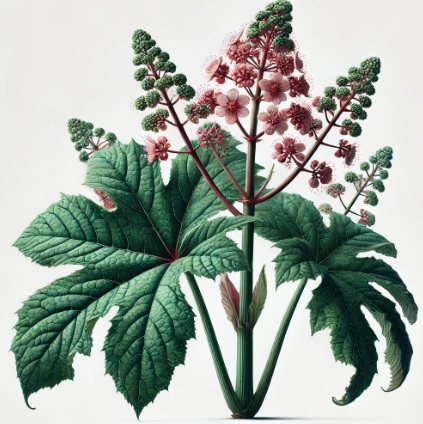The Polygonaceae family, commonly known as the knotweed or smartweed family, is a diverse group of plants in the order Caryophyllales. It consists of around 50 genera and 1200 species, found in a wide range of environments, from temperate to tropical regions. The family includes herbaceous plants, shrubs, and small trees, many of which are known for their ability to grow in disturbed soils and as weeds.
General Description
The plants in the Polygonaceae family vary widely in form, but they are generally characterized by the following features:
- Leaves: Alternate and simple, often with stipules at the base that form a unique sheath around the stem, known as an ocrea.
- Flowers: Small, usually unisexual, and often clustered in spikes or panicles. The flowers lack petals, but they are typically surrounded by sepals.
- Fruits: The fruit is usually a hard, small achene, often surrounded by a persistent calyx.
Members of this family can be found in a variety of habitats, but many species are especially common in disturbed areas such as roadsides, fields, and riverbanks.
Chemical Composition
The Polygonaceae family contains a variety of bioactive compounds, including flavonoids, tannins, anthraquinones, and alkaloids. Some species, like Polygonum cuspidatum (Japanese knotweed), are rich in resveratrol, a polyphenolic compound known for its antioxidant properties. Other species in the family contain compounds with potential antimicrobial, anti-inflammatory, and antioxidant activities. Some species, like Rheum (rhubarb), contain anthraquinones, which have laxative effects and are used in traditional medicine.
Physical Properties
The plants in the Polygonaceae family tend to have:
- Stems: Often swollen at the nodes, giving them a characteristic jointed appearance.
- Leaves: Typically large, ovate, and alternate, with stipules that form an ocrea, which is a membranous sheath around the stem.
- Flowers: Small, usually greenish or pinkish, and often inconspicuous, arranged in dense clusters or spikes.
- Fruits: Generally small, hard, and surrounded by a persistent calyx.
Some species are climbing plants, such as Polygonum species, while others are low-growing herbs. Many species in this family are known for their vigorous growth and ability to colonize disturbed sites rapidly.
Production Process
Plants in the Polygonaceae family are propagated mainly by seed, although some species can also be propagated by rhizomes or cuttings. These plants often thrive in disturbed soil, which makes them useful for erosion control and soil stabilization. For medicinal purposes, specific parts of the plants, such as the rhizomes or roots, are harvested for extraction. For example, the roots of Polygonum cuspidatum are commonly used to produce resveratrol and other bioactive compounds.
Applications
Medicinal
Many species in the Polygonaceae family have traditional medicinal uses. Some of the most notable plants in this family include:
- Japanese Knotweed (Polygonum cuspidatum), used in traditional medicine for its antioxidant, anti-inflammatory, and antimicrobial properties, especially due to its resveratrol content. It is also studied for its potential role in supporting cardiovascular health and reducing inflammation.
- Rhubarb (Rheum), which is used for its digestive benefits and as a mild laxative due to the presence of anthraquinones.
- Smartweed (Polygonum hydropiper), which has been used for its anti-inflammatory and analgesic effects in traditional herbal medicine.
Culinary
Polygonaceae includes several species that are important in the culinary world, most notably:
- Rhubarb (Rheum), whose tart stalks are used in pies, jams, and sauces.
- Buckwheat (Fagopyrum esculentum), a grain-like seed that is used in cooking and baking, particularly in pancakes, noodles, and porridge. It is gluten-free and a good source of protein and fiber.
Environmental
Some plants in the Polygonaceae family, such as Polygonum cuspidatum (Japanese knotweed), are used for erosion control, particularly in areas where other vegetation has difficulty growing. Their vigorous growth helps stabilize soil and prevent erosion on riverbanks and slopes. However, it's important to note that some species, like Japanese knotweed, are considered invasive and can damage native ecosystems by outcompeting local flora.
Ornamental
Several species of Polygonaceae, particularly those in the Polygonum genus, are grown as ornamental plants. These plants are prized for their attractive foliage and flowers, and they are often used in gardens, landscapes, and as groundcovers. For example, Persicaria species (formerly part of Polygonum) are used in landscaping for their vibrant flowers and ability to thrive in damp environments.
Environmental and Safety Considerations
While many species in the Polygonaceae family are used in food and medicine, some species can be toxic, especially if consumed in large quantities. For instance, rhubarb leaves contain oxalates, which can be toxic when ingested. Additionally, Japanese knotweed can be invasive and difficult to control once established, potentially disrupting local ecosystems.
As with any plant used for medicinal purposes, it is important to follow guidelines and consult with a healthcare professional to ensure safe use, especially when dealing with potent compounds like resveratrol and anthraquinones.
INCI Functions
- Antioxidant: Protects the skin from oxidative damage.
- Anti-inflammatory: Reduces inflammation in the skin.
- Moisturizing: Helps maintain skin hydration.
- Antimicrobial: Inhibits the growth of harmful microorganisms.
In conclusion, the Polygonaceae family is a diverse and ecologically significant group of plants, with many species offering medicinal, culinary, ornamental, and environmental benefits. While some plants in this family have invasive tendencies, their uses in food, medicine, and environmental applications highlight their importance across various fields.
![]() Polygonaceae
Polygonaceae 

